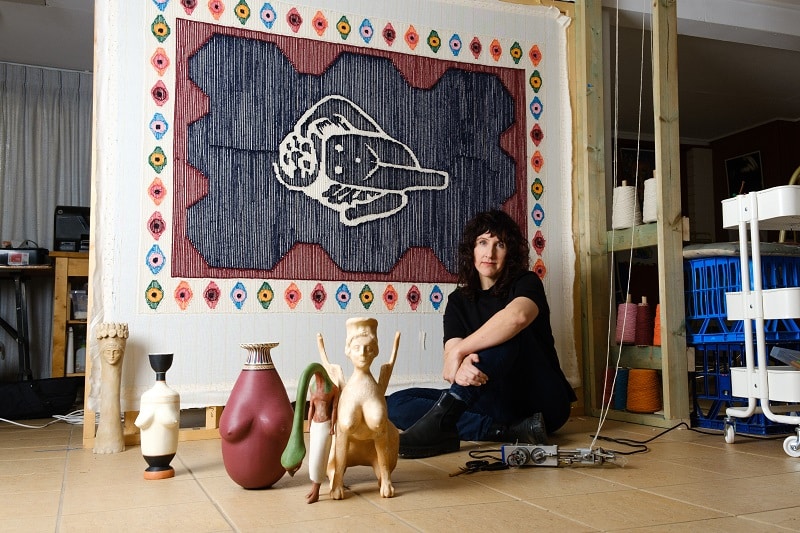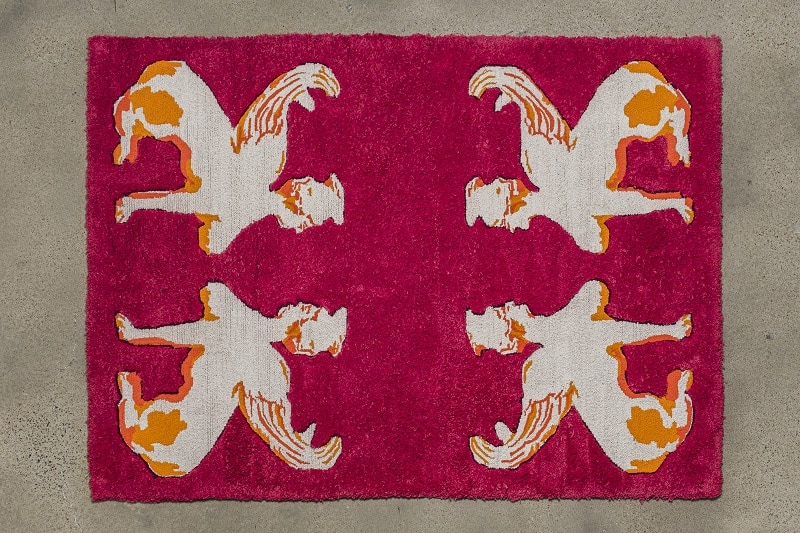Natalya Hughes is a Brisbane-based artist who is passionate about exploring the representation of women in art. She sources art historical imagery from books and the Internet as as starting point in her appropriation-based practice. Her works are vibrant in colour and intricate design, with symbolic patterns articulated through painting, textiles, and technology, and most recently she has explored 3D printed sculptural forms and ventured into custom made furniture for ‘The Interior‘.
In this interview Hughes tells us about what drives her arts practice, and explains her processes, and reveals the Freudian inspiration behind her latest exhibition.
Why is appropriation a good starting point?
It’s in part just how I always work. Rather to the blank page, I’ve always responded to imagery that exists just wanting to understand the way it works. There’s that kind of impulse and curiosity around other people’s practices but it’s also that I’ve been fairly preoccupied with the way women are represented and for whom. It’s changed quite dramatically over the years depending on what the object of investigation is and what the kind of visual language is. The other thing that I’ve looked at across all those different appropriation works are heavily decorative traditions or traditions that have vehemently pushed against the decorative for one reason or another.

What draws you to the intricacies of patterning?
It’s complicated. I used to appropriate patterns as well but it’s not the cultural moment for that. I started building my own around the time of my PhD trying to build my own decorative language. Something of my family, of my mum’s aesthetic was working its way through in some ways. I think about my obsession with this little cake of soap that she had it’s called Maja and when I was about ten my Nana gave me this book illustrated by Erté that belonged to my Grandfather it was pale pink and pale blue. I remember my curiosity around those aesthetics in particular, which were quite decorative and graphic.
As I studied art at university, I became more interested, less in terms of the formal kind of something being decorative and more about the value judgement that’s usually placed when we’ve named something as decorative.
Pattern I think has got a more comfortable place in the history of art. It’s at home in certain traditions of formalism but to call a painters work decorative is still a bit of an insult. I think I was much more interested in that evaluation. Placing it in a larger kind of framework of what gets devalued and what gets held up, its formal capacities but also what we associate it with.
How do you create a new pattern?
It depends on the project. With The Interior I used Freud’s treatment room and in particular Freud’s couch as the starting point but also thinking through other visual elements that work their way through psychoanalysis and case studies of psychoanalysis. So, the language as well as the imagery that was associated with it.
I could have just worked with the motif that was on the imagery in Freud’s treatment room and sometimes I do when it comes to the antiquities but with things like the rugs, again it would be a form of cultural appropriation, so I wanted to steer clear of that, and think instead, whether I could make a decorative language from the other stuff that psychoanalysis has on offer.
I started with drawings from his very well-known case studies like Wolf Man or the Rat Man and then some of the more obscure texts I’ve read, to find what were some quite compelling images and working those in. For this, I was making watercolours of individual motifs then in Photoshop I make the repeat motif. It’s a combination of analogue and digital techniques.
Why is it important for you to bring focus to the representation of women in art history?
In art history… I think since second wave feminism has come to try and question the way women have been represented.
With this current body of work, I became really aware in teaching that more still needed to be done working with students in particular. Photography students especially would show [me] a torso with its head cut off in a kind of Edward Weston style image and when you ask about why they had done that particular framing they would say that it was about the female form.
And I would say “which female and why?”
Just the conventional nature of that, the fact that it is still just an unproblematic way of working and representing. I just I felt like there was an urgency because I think it has something to do with not dehumanising but at least putting yourself at a distance with the subject that you’re representing and there’s problems with that. I can see the follow through, the social problems that we have where we don’t accord women with the same kind of subjectivity that we might afford men.
Despite how much has been done it’s still an issue when I think about which practises are revered and which ones are challenged.
My interest is in how things play out in art history and the contribution I make is to history. I don’t expect anyone to go to my show and just get over their misogyny but just to raise the question of that is my goal. Hoping to get people to ask ‘why?’
You’ve been exploring 3D printing and custom furniture can you talk about that?
The objects were made with the assistance of the young artist called Max Athens. They’re all based on objects in Freud’s collection that he had in this treatment room. He was a huge collector of antiquities, and he had thousands of sculptures and prints and different things that he kept in his treatment room.
Freud was quite invested in the idea that the process of psychoanalysis had a kind of relationship to the process of archaeology where you kind of dig away the layers and find new knowledge, so there was a lot to work with.
We started with images that you can find on the Freud Museum website and books that I have, and like the terracotta sphinx that he had. It was a matter of morphing them in the same way I do paintings I guess, making them more bodily. [My] sphinx has these exaggerated breasts, the original had the head of a woman and the chest of a woman in some representation but in this they are so exaggerated you can’t look past them. So that gendering of the object is really clear.
There are a lot of myths that Freud talks about in his writing and most of them have to do with the way Freud was trying to reckon with the way women are constructed or the way they are perceived. So, it was a matter of exaggerating them and making them a key part of the room. They are very precise and convincing as objects in their own right.
I had worked with a fabricator in Brisbane on stands for my ‘de Kooning’ paintings, so I could put textiles on the back but also so de Kooning’s women could be off the wall and kind of physically in the space, so that you could walk around them and be more aware of your body in encountering these representations. He helped me do quite specific and sort of funny forms and sometimes quite provocative stuff and he just has the best response to it. He was so interested in making my idea happen. If you could imagine going to a fabricator and saying “I want to make these lounges that are in the shape of boobs. And I want these boobs to be even, and I want these boobs to be really lopsided,” and he just said, “OK what do you think of this shape?”

Looking at the representation of women and Freud how do these ideas transpire in The Interior?
In part, I should say that there’s been a lot of feminist criticism of Freud and some of his ideas and I’m aware of those but I’m not critical of psychoanalysis as a whole. I’m very much an advocate for it at a personal level and also at a social level because I think in every instance people are often acting without awareness of their quite complicated feelings, their ambivalence, their aggression, sometimes their hostility, their complicated love for example.
I’ve staged the show because I have a certain level of belief in what psychoanalysis offers as far as us talking through the issues and acknowledging how we feel about certain things.
I don’t expect that to play out in the gallery necessarily. I’m not imagining that people will climb into the chairs and suddenly one untrained person can act as analyst and another completely new person to the field can talk about their problems and get over them.
I just wanted it to be part of the dialogue to be a way of talking about what might be required next.
We are living in quite interesting times, I wanted to work spatially and aesthetically with a kind of discourse or a field that I feel has something positive for the here and now.